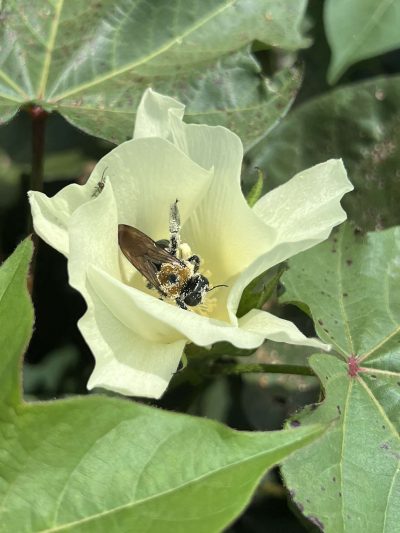Given that the UF/IFAS Extension theme for the Sunbelt Ag Expo and the North Florida Fair exhibits were pollinators, I want to talk about pollinators in agronomic crops. Are they beneficial to your crops? Are crops beneficial to pollinators?
Pollination by insects is a critical ecosystem service necessary to produce most food and fiber crops, including those providing essential nutrients for food security. However, not all crops are the same regarding their dependence on pollinators for fruit and seed production. You may be familiar with crops like almonds, apples, and squash having specific pollination requirements, which we call pollinator-dependent crops. Agronomic crops like cotton, peanut, soybean, and corn have the ability to self-pollinate or are wind-pollinated and do not necessarily need pollinators for crop production. These crops are termed pollinator-independent. Now, aside from being pollinator-independent, one thing these crops have in common is that they are mass flowering crops, producing a tremendous amount of flowers throughout the growing season. For example, soybeans can produce up to 800 florets per plant and up to 500K per acre. Or think of a cotton field at harvest; each boll was a flower at one point in time during the growing season. These flowers can potentially provide large amounts of pollen and nectar for visiting bees. Bees depend on pollen and nectar to provide carbohydrates, protein, lipids, amino acids, and other micronutrients in the form of pollen and nectar provided by flowers to sustain themselves and their developing offspring.
–

Figure 1. Bracteal extrafloral nectary on the underside of a cotton bloom producing a drop of nectar. Photo by Isaac Esquivel, UF/IFAS
How do crops like cotton benefit bees?
Cotton flowers produce an abundance of pollen and nectar. Cotton flowers have anywhere between 0-3 extrafloral nectaries under the bracts of the flower (Figure 1.). Many beneficial insects like syrphid flies and parasitoid wasps use these as sugar sources in addition to pollinators. However, little is known about the nutritional content of agronomic crop floral resources and their implications on pollinator health. We have done some surveys this past season and have seen multiple species of wild bees and managed honey bees, both visiting cotton flowers for pollen and visiting extrafloral nectaries for nectar (Figure 2).
–

Figure 2. A bumble bee foraging in a cotton bloom covered in pollen. Photo by Isaac Esquivel, UF/IFAS
What bees are visiting these crops?
Both wild bees and managed bees (honey bees) visit agronomic crops. We have found up to 34 different species of wild bees in both Texas & Mississippi cotton systems. Some of these bees are consistent with what we have seen so far in our Panhandle crops, but complete surveys have yet to be done. One particular group of bees that seem to be most abundant in agronomic cropping systems are long-horned bees (Genus: Mellissodes spp.) (Figure 3). These groups of bees are solitary ground nesters, meaning that each female bee builds her nest and forages for provisions for her brood. Ground-nesting bees may sometimes aggregate nests in favorable soil but keep individual nests. Recently, we found an aggregation of Melissodes communis (common long-horned bee) nests within a nitrogen rate study at the NFREC-Quincy. Old literature from the ’70s suggests that some of these bees do, in fact, nest in cotton fields but usually was disregarded due to the fact that tillage can disrupt ground-nesting bees. This aggregation of bees is hopeful to look into the effect of agricultural production on ground-nesting bees, given these bees are abundant in cotton systems.

Figure 3. A male common long-horned bee (Melissodes communis) leaving its nesting site. Nesting aggregation is located in a nitrogen rate trail at the NFREC in Quincy. Photo by Isaac Esquivel, UF/IFAS
–
Do bees benefit agronomic crops?
Even though pollinator-independent crops do not require pollination to produce a yield, they can still benefit from bee visitation. Studies on the effects of pollination on these crops have increased in the past couple of years, and most cases indicate positive effects on crop production. In work done in South Texas during my graduate program, we ran a replicated pollinator exclusion experiment over two years. Cotton plants were caged and excluded from pollinators, caged with wild bees, caged with hand-crossed flowers, and uncaged plants. We found that bolls produced from flowers exposed to wild bees and hand-crossed flowers had higher seed cotton weights on average than those produced from pollinator-excluded plants. This increased weight was about 30%, on a per-boll basis, and 12% across the whole plant yield.
Studies are limited on pollination in pollinator-independent crops. However, these crops appear to have a diverse array of wild bees. More work is needed to understand how these bees persist and possibly thrive in agricultural systems like cotton production, the potential benefits these crops have to bees, and what benefits bees have to these crops.
Resources:
–
Wild Bee Diversity in Cotton
–
